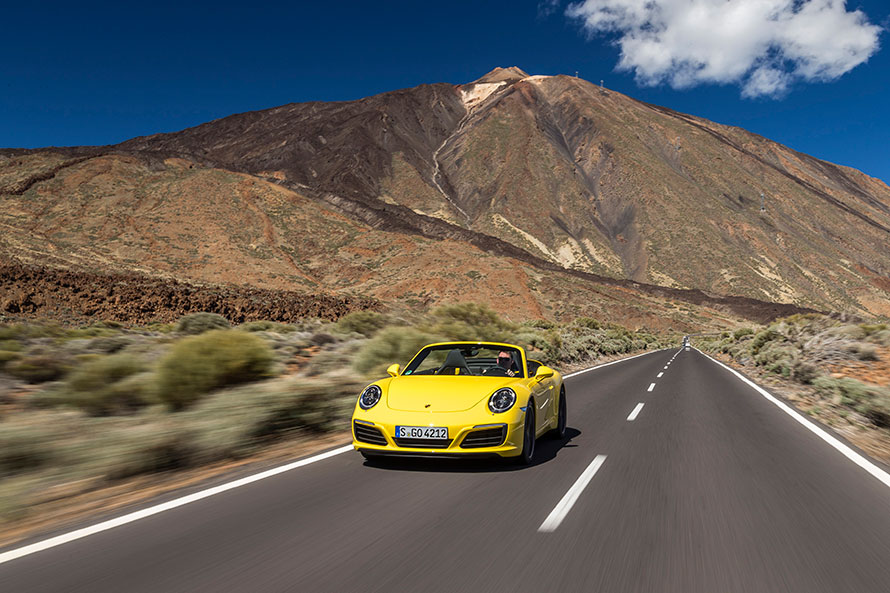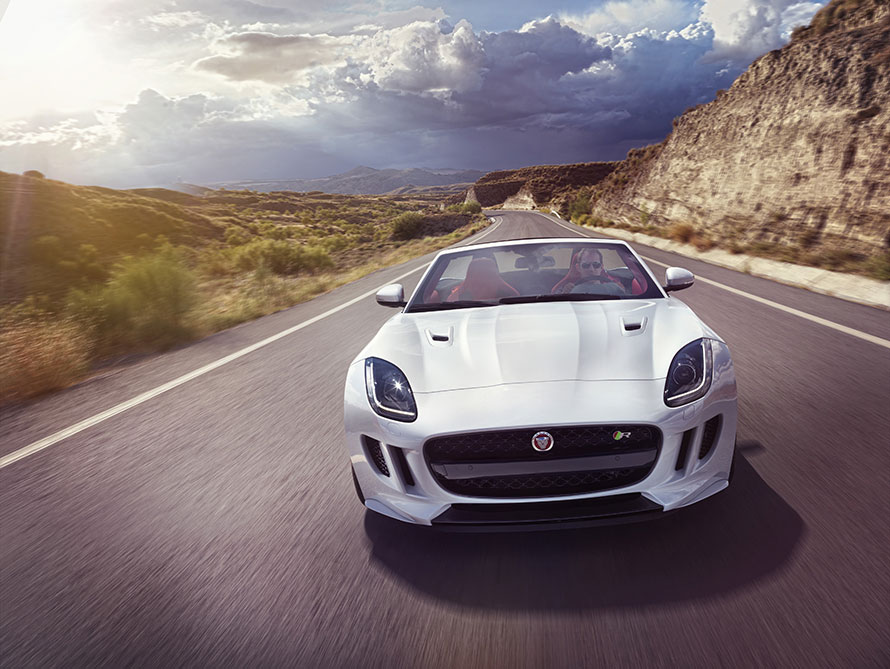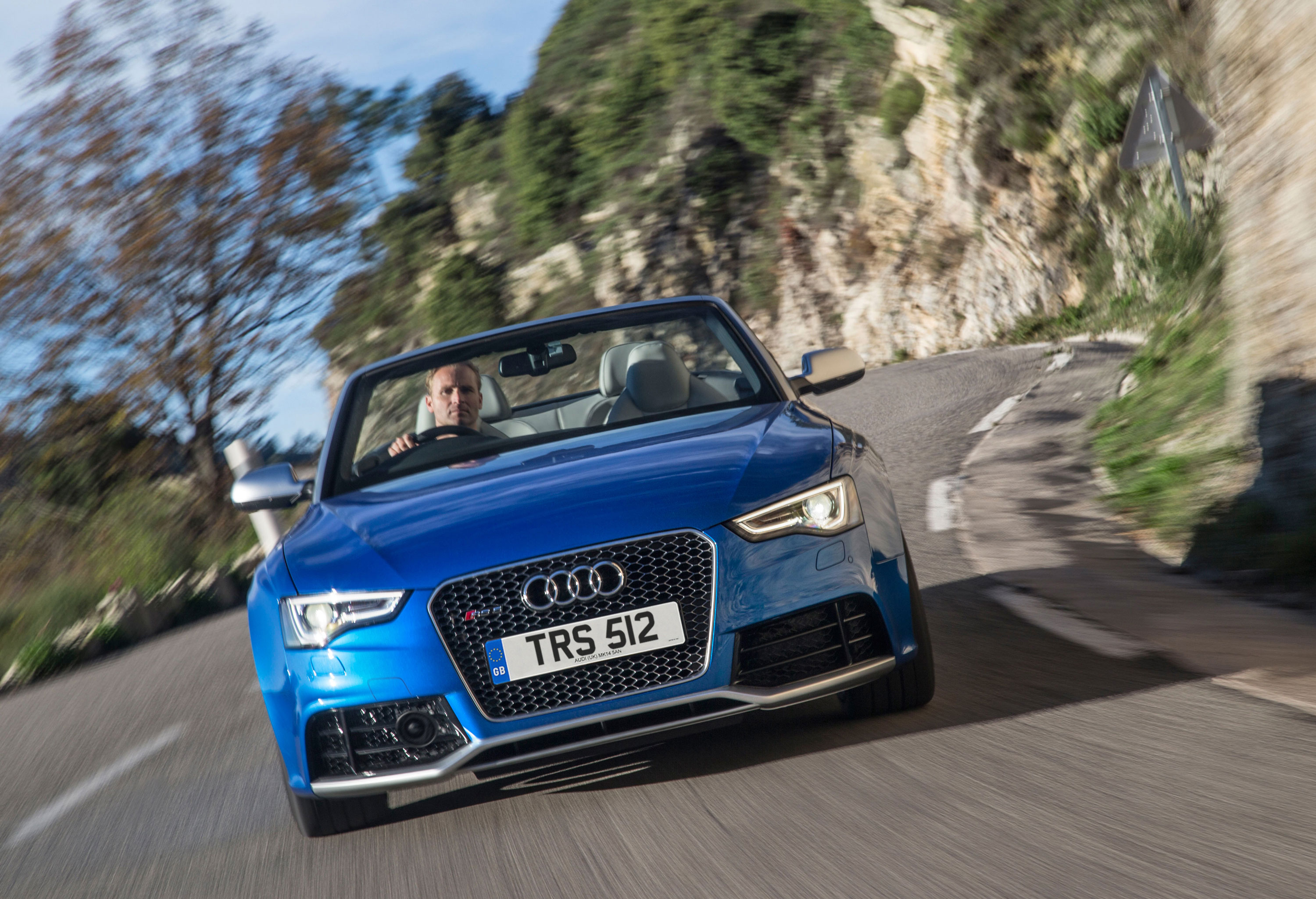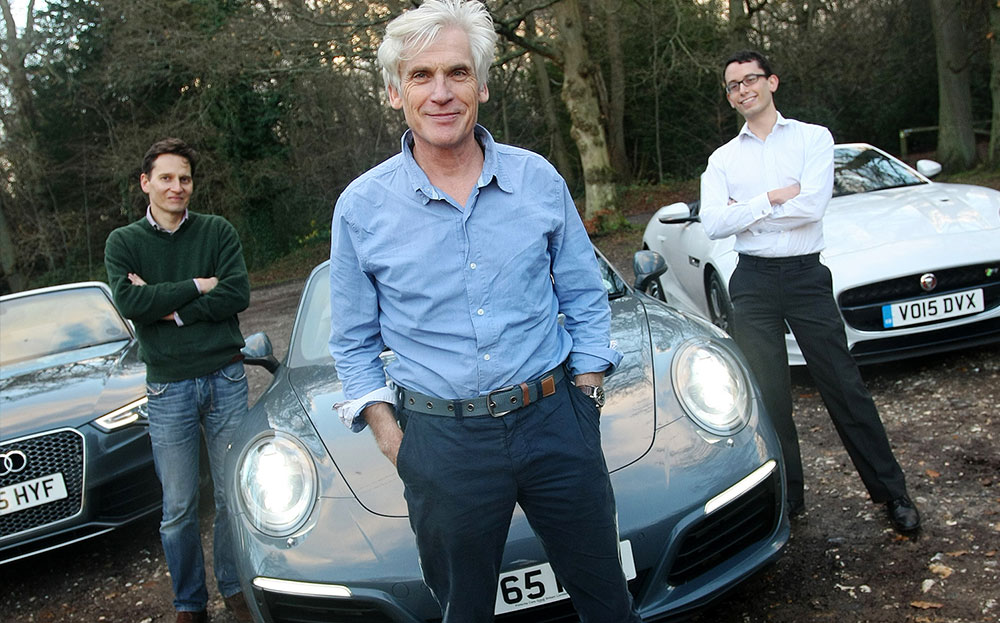Sports convertibles go head to head: Porsche 911, Jaguar F-type & Audi RS 5 battle
Go topless in winter and get all the thrills without chills
IT’S WINTER. Time to huddle into a solid-roofed car where there’s no chance of a rattly soft-top letting in the wind and rain. Think again: in these cabriolets you don’t need to fear the noise — or the cold. Put the hood down, even on a December day, and you can enjoy the winter sunshine while being cossetted by heaters that blow warm air round the cabin and keep your seat cosy. With clever air deflectors you can listen to the radio and talk to your passenger without being buffeted.
Browse NEW or USED cars for sale on driving.co.uk
But which to choose? Rather than fly off to sunny climes like your average motoring correspondent to compare the three, we braved the chills of Surrey to give them a thoroughly British workout.
OK, a reality check. Who wouldn’t want one of these cars? It’s a bit like the menu options in business class. Any is better than sitting in economy. Putting them side by side and comparing them wheel nut for wheel nut as we have done is what pedantic motoring hacks enjoy but the truth is each excels in its own right. It depends on what you’re looking for — a practical four-seater (the Audi), a knuckle-whitening roadster (the Jag) or a combination of the two (the Porsche).
But when you’re spending upwards of £69,000, you need to compare and contrast, right? That’s our excuse, anyway.
2016 Porsche 911 Carrera S cabriolet

Words: Nick Rufford
In the 1971 film Le Mans, Steve McQueen arrives at the circuit in a slate-grey 911. More than 40 years on, the actor would recognise his character’s 911 in the latest addition to the Porsche stable. It has double the power and double the fuel economy of the earlier machine, and is twice as quick to 60mph, but the same heart beats beneath. The design is still fundamentally that of Ferdinand Porsche, grandson of the German designer who created the VW Beetle at Hitler’s request: a flat-six engine mounted in the rear, a manual gearbox and a Beetle-like silhouette. The logic of putting the engine at the back was for mechanical simplicity and to improve traction, and the same laws of physics apply today.
What’s changed is that because of ever-tightening emissions regulations, all 911s — including this Carrera S cabriolet — have not one but two turbochargers and a smaller 3-litre engine. Some argue that this spoils the character of the engine; that the arrangement mutes its distinctive howl and gives it so much pulling power low in the rev range that driving one quickly is no more taxing than driving a turbodiesel VW Golf.
Yet drivers still get to enjoy the wailing note of the two banks of three cylinders that fire in opposite directions, and with the roof down — a touch-of-the-button process that takes 13 seconds — it sounds fantastic going up Zig Zag Hill near Dorking, even if it doesn’t quite make your hair stand on end as the Jaguar does.
What’s obviously different between the latest car and the un-turboed Carrera that it replaces is the way it builds speed. In its predecessor, the engine thrived on high revs and the power and noise were delivered in a crescendo. Take the car by the scruff of the neck, drive it hard and you got the rewards.
Compared with the front-engined Jag, the steering seems tauter, the brakes sharper and the car more grippy and planted
Now, with so much torque, you can pootle around town in third or fourth gear and never change up or down. A couple of times I forgot it was a manual and stalled it at roundabouts (easily remedied by dipping the clutch to engage stop-start).
Being so obedient, can it still live up to its name? Carrera celebrates Porsche’s 1950s exploits in the Carrera Panamericana, a race on open roads in Mexico. True, the latest Carrera doesn’t feel as red-blooded as it used to but it’s still blindingly quick — 0.2 seconds faster to 62mph than the previous Carrera S — and with that turn of speed you need a level of control to match.
Compared with the front-engined Jag, the steering seems tauter, the brakes sharper and the car more grippy and planted. It’s got better visibility from the cockpit than the F-type, too, even though it lacks the dramatic looks of the British roadster. And small things, such as a comfortable diving position, supportive seats and plenty of space for your feet, make it a car that’s suited to spending hours on end at the wheel — more so than the Jag.
One thing: our test car came with the standard seven-speed manual gearbox. It’s always satisfying to jump back into a sports car where you have to lift more than a finger to change gear — most cars these days coming with flappy-paddle systems. But once picturesque roads such as Zig Zag Hill come to an end, and you find yourself back on the stop-start grind of the M25, you may pine for Porsche’s PDK automatic system — which would bump up the price to £97,086.
The two-wheel-drive Carrera S cabriolet is also available with four-wheel drive. That version, called the Carrera 4S, would match the Jaguar for traction but costs more, at £102,072, when fitted with a PDK transmission. Compare that with the $1.37m that McQueen’s Le Mans 911 fetched at auction four years ago, though, and you might decide it’s a snip.
After an afternoon winding our way around hairpins before battling back into London, the latest 911 may have lacked a little of the fizz and pop that made predecessors so appealing, but it marked itself out as the consummate all-rounder.
2016 Porsche 911 Carrera S cabriolet
- Engine: 2981cc, 6 cylinders, twin turbo
- Power: 414bhp @ 6500rpm
- Torque: 368 lb ft @ 1700rpm
- Transmission: 7-speed manual, rear-wheel drive
- Acceleration: 0-62mph in 4.5sec
- Top speed: 155mph (limited)
- Fuel: 32.1mpg (combined)
- CO2: 202g/km
- Roof opening time: 13 seconds
- Price: £94,698
- Rating: ★★★★★
- Verdict: Turbo power with fingertip control
2015 Jaguar F-type R

Words: Dominic Tobin
The Jaguar F-type’s weapon is no secret. You couldn’t miss it from a mile away: the four exhaust pipes from the supercharged V8 engine bark, snarl and pop. Porsche’s 911 might sound more tuneful, but the noise from the F-type is more exciting, and cars will queue behind just to listen to the show.
The F-type has the biggest engine and the most power and it is fastest to 62mph — just 4.1 seconds. From its bulging bonnet to the tips of those exhausts, the Jaguar is a celebration of pure power that merits its own art deco poster with diagonal perspective lines and speed blurs, just like steam engines of the 1930s.
It’s the basics that shine through: if you use the steering wheel paddles to change gear, shifts are smooth and quick. But there’s no shame in leaving the eight-speed box in automatic: the software does an impressive job of picking the right gear.
Our test car was fitted with a four-wheel-drive system that added almost £5,000 to the price, but it transforms the behaviour of the F-type by sending up to 30% of power to the front wheels when needed. Where the rear-wheel-drive models slither alarmingly when you accelerate from a corner on damp tarmac, our all-wheel-drive car clung determinedly to Zig Zag Hill, even as we put the power on in the middle of a turn.
The performance figures are more impressive, too, with acceleration from 0-62mph 0.1sec quicker than the rear-wheel-drive version. More importantly, the four-wheel drive gives the driver more confidence to use the power in the knowledge that the car is less likely to slide you into the hedgerow. The only complaint is that it occasionally feels a little too wide for comfort (at 1923mm) on narrow roads.
By the time you’ve added some basic options — such as your choice of paint and climate control — it is a six-figure car
The cost? Ah. This top-of-the range model starts at £97,145 (the entry-level model is £40,000 cheaper). By the time you’ve added some basic options — such as your choice of paint and climate control — it is a six-figure car. And running costs aren’t cheap: we saw 33mpg from the Porsche on a motorway trip. The F-type barely managed 23mpg.
Distracting from all that practicality, though, is the way it looks. We couldn’t find anyone who disagreed that it was the most stylish of the trio. It managed to make the Porsche look ordinary and the Audi downright dumpy. The trade-off for the classic long-bonnet, short-tail silhouette is that the car is strictly a two-seater with a boot so small it will force you to leave half your weekend bags at home. But then, isn’t that what a sports car is all about: looks, power and sound? Once you start to compromise, why not buy an estate car?
Colleagues had their criticisms of its suspension, which is firm in its standard setting but not as jarring as they make out. Winter driving with the roof down is comfortable enough: put the windows up and they work with the wind deflector to protect occupants from most of the turbulence at motorway speeds, while toasty heated seats and a blast of hot air from the vents keep them warm — although the Porsche does the job just as well.
There are some signs of the fact the German firm has had more than 50 years to develop the 911 whereas Jaguar was, until recently, looking like a lost cause. The seats are not as comfortable as its German rivals — particularly on longer journeys — and the software for the dashboard touchscreen looks as if it pre-dates the iPhone.
Just zooming in and out of the sat nav map to check your route requires a series of button presses, whereas it can be achieved with a quick twist of a dial in the other cars — easier to manage during a stop at a red light.
It wouldn’t be surprising if owners relied on their smartphone for directions, or simply decided to get lost. Because, for all the admiring glances you get when you pull up at the roadside, this car is all about the thrilling, sonorous and joyful journey. No sat nav or radio needed.
Jaguar F-type R convertible AWD automatic
- Engine: 5000cc, V8, supercharged
- Power: 543bhp @ 6500rpm
- Torque: 502 lb ft @ 3500rpm
- Transmission: 8-speed auto, 4-wheel drive
- Performance: 0-62mph in 4.1sec
- Top speed: 186mph
- Fuel: 25mpg (combined)
- CO2: 269g/km
- Price: £97,145
- Roof opening time: 12 seconds
- Rating: ★★★★★
- Verdict: Red in tooth and claw
Audi RS 5 cabriolet

Words: James Mills
Have you seen a grown man try to contort himself into the back seat of a Porsche 911 cabriolet? No? I have. Even with the roof down, the process involved Nick Rufford performing a gymnastic display of limb bending and leg splaying and some choice profanities. And that’s before the roof is closed, compressing his spine by a further few inches.
The Audi, by contrast, is a genuine four-seat car that will accommodate four burly rugby players in comfort. There’s a boot large enough to hold a decent amount of luggage too — something the Porsche and Jaguar will struggle to do.
But we didn’t come to Zig Zag Hill to peer inside boots and discuss legroom. We came to lower the roof, feel the sun on our faces and enjoy the bellow of a good old-fashioned V8 engine bouncing off the hillsides. At this stage, I’ll admit the Audi is a bit old-fashioned. Unlike its rivals there’s not a clever turbocharger or, for that matter, supercharger in sight. Instead, the performance is dictated by cubic inches and a tolerance of being revved to nearly 8300rpm.
All that cabin space to stretch out in takes its toll on the RS 5’s athleticism. This is a chubby car, about 350kg heavier than the Porsche
That has its upside and its downside. The upside is that it sounds fabulous as those revs climb ever higher — this engine has deservedly powered the acclaimed R8, among other RS Audi models. The downside is that the RS 5 is often caught napping by the turbocharged 911 and Jaguar’s ballistic F-type R.
If the driver hasn’t set the S tronic dual-clutch transmission to Sport, or opted to change gear manually with the fingertip paddles behind the steering wheel, the engine has precious little performance low in the rev range. Funny that; it reminds me of something — oh yes, the last version of the naturally aspirated 911.
All that cabin space to stretch out in takes its toll on the RS 5’s athleticism. This is a chubby car, about 350kg heavier than the Porsche. It also sits higher off the ground, so it feels like a go-fast Audi rather than a thoroughbred sports car. There’s no agility in the way it tackles a winding road, although the traction on greasy surfaces is impressive.
But when the time arrived to drive home or give friends a ride at the weekend, the Audi came into its own. It’s comfortable, and its engine is a gem. Then you take a look at the price: a new one of these would save drivers about £25,000 over its rivals. This is an old car on its last legs, but nonetheless it puts up a heroic fight.
2015 Audi RS 5 cabriolet
- Engine: 4163cc, V8, naturally aspirated
- Power: 443bhp @ 8250rpm
- Torque: 317 lb ft @ 4000rpm
- Transmission: 7-speed S tronic auto, 4-wheel drive
- Acceleration: 0-62mph in 4.9sec
- Top speed: 155mph (limited)
- Fuel: 26.4mpg (combined)
- CO2: 249g/km
- Roof opening time: 15 seconds
- Price: £69,555
- Rating: ★★★★☆
- Verdict: This veteran’s still in the fight
View the convertibles for sale on driving.co.uk





